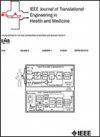A Deep Learning Model for Predicting ICU Discharge Readiness and Estimating Excess ICU Stay Duration
IF 4.4
3区 医学
Q2 ENGINEERING, BIOMEDICAL
IEEE Journal of Translational Engineering in Health and Medicine-Jtehm
Pub Date : 2025-08-18
DOI:10.1109/JTEHM.2025.3600110
引用次数: 0
Abstract
Objective: In the complex landscape of ICU operations, accurate discharge decisions are crucial yet challenging, as premature discharge risks readmission and mortality while prolonged stays consume resources and heighten infection risk. The objective of this work is to develop a deep learning-based Discharge Readiness Score (DRS) model using minimal clinical features to predict ICU discharge readiness, and to highlight its application in estimating excess ICU stays for resource optimization. Methods and procedures: We utilized nearly 1.8 million ICU patient-stays from 2007–2023 across 300 US hospitals in the Philips eICU database. Six readily available features (age, mean arterial pressure, systolic pressure, heart rate, respiratory rate, and Glasgow Coma Scale) were used as inputs. A 5-layer neural network predicted patient mortality within 48 hours post-ICU discharge as a proxy for discharge readiness. The model was trained on 80% of data, validated on 10%, and tested on 10% (approximately 180,000 patients). We applied the model hourly to estimate excess ICU stays, defining excess stay as the time patients remained at low risk but continued in ICU. Results: The model achieved an AUC of 0.93 on the test set. Performance was consistent across years, ethnicities, ICU types, and admission groups. Using the model, we found that about 22% of patients had excess ICU time, with a median of 16 hours. The analysis highlighted trends over time and across ICU types, providing insights into resource utilization. Conclusion: The DRS model effectively predicts ICU discharge readiness using minimal features and can estimate excess ICU stays, aiding resource optimization. Clinical Impact— The model offers a practical tool for ICU discharge planning and resource utilization analysis, potentially improving patient outcomes and ICU operations预测ICU出院准备和估计ICU超额住院时间的深度学习模型
目的:在复杂的ICU手术环境中,准确的出院决策至关重要,但也具有挑战性,因为过早出院有再入院和死亡的风险,而延长住院时间会消耗资源并增加感染风险。这项工作的目的是开发一个基于深度学习的出院准备评分(DRS)模型,使用最小的临床特征来预测ICU出院准备情况,并强调其在估计ICU多余住院时间方面的应用,以实现资源优化。方法和程序:我们利用飞利浦eICU数据库中300家美国医院2007-2023年的近180万ICU患者。6个容易获得的特征(年龄、平均动脉压、收缩压、心率、呼吸频率和格拉斯哥昏迷量表)作为输入。5层神经网络预测患者出院后48小时内的死亡率,作为出院准备的代理。该模型在80%的数据上进行了训练,在10%的数据上进行了验证,在10%的数据上进行了测试(大约18万名患者)。我们应用每小时模型来估计额外的ICU住院时间,将额外住院时间定义为患者保持低风险但继续在ICU的时间。结果:该模型在测试集上的AUC为0.93。不同年龄、种族、ICU类型和入院组的表现一致。使用该模型,我们发现约22%的患者有多余的ICU时间,中位数为16小时。该分析强调了随着时间的推移和ICU类型的趋势,提供了对资源利用的见解。结论:DRS模型利用最小特征有效预测ICU出院准备情况,并可估计ICU多余住院时间,有助于资源优化。临床影响-该模型为ICU出院计划和资源利用分析提供了实用工具,可能改善患者预后和ICU操作
本文章由计算机程序翻译,如有差异,请以英文原文为准。
求助全文
约1分钟内获得全文
求助全文
来源期刊

IEEE Journal of Translational Engineering in Health and Medicine-Jtehm
Engineering-Biomedical Engineering
CiteScore
7.40
自引率
2.90%
发文量
65
审稿时长
27 weeks
期刊介绍:
The IEEE Journal of Translational Engineering in Health and Medicine is an open access product that bridges the engineering and clinical worlds, focusing on detailed descriptions of advanced technical solutions to a clinical need along with clinical results and healthcare relevance. The journal provides a platform for state-of-the-art technology directions in the interdisciplinary field of biomedical engineering, embracing engineering, life sciences and medicine. A unique aspect of the journal is its ability to foster a collaboration between physicians and engineers for presenting broad and compelling real world technological and engineering solutions that can be implemented in the interest of improving quality of patient care and treatment outcomes, thereby reducing costs and improving efficiency. The journal provides an active forum for clinical research and relevant state-of the-art technology for members of all the IEEE societies that have an interest in biomedical engineering as well as reaching out directly to physicians and the medical community through the American Medical Association (AMA) and other clinical societies. The scope of the journal includes, but is not limited, to topics on: Medical devices, healthcare delivery systems, global healthcare initiatives, and ICT based services; Technological relevance to healthcare cost reduction; Technology affecting healthcare management, decision-making, and policy; Advanced technical work that is applied to solving specific clinical needs.
 求助内容:
求助内容: 应助结果提醒方式:
应助结果提醒方式:


